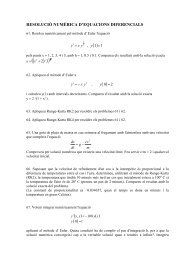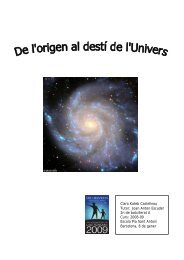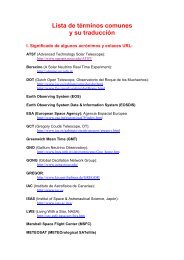Universitat de - Departament d'Astronomia i Meteorologia ...
Universitat de - Departament d'Astronomia i Meteorologia ...
Universitat de - Departament d'Astronomia i Meteorologia ...
Create successful ePaper yourself
Turn your PDF publications into a flip-book with our unique Google optimized e-Paper software.
72 Chapter 2. Multiwavelength approach to LS 5039<br />
In HMXBs the presence of an emission line around 6.4 keV is commonly seen,<br />
with a variety of strengths. It is ascribed to fluorescent reprocessing by neutral or<br />
mildly ionized iron in relatively cold circumstellar material (Fe Kα line). A higher<br />
energy implies the presence of highly ionized iron (He-like ∼ FeXXV) or a different<br />
origin than Kα emission. One possibility would be radiative recombinations of H-<br />
like iron followed by casca<strong>de</strong> processes in a relatively hot corona. Unfortunately, the<br />
PCA energy resolution prevents from distinguishing between these possible mo<strong>de</strong>ls.<br />
On the other hand, the high EWline(Fe) value indicates that a large amount of<br />
circumstellar matter is present in the system. Since LS 5039 lies at low galactic<br />
latitu<strong>de</strong>, we cannot rule out that part of the emission feature comes from the Galactic<br />
ridge (Yamauchi & Koyama 1993). Nevertheless, this contribution cannot account<br />
for the total flux of the line. In addition, Wang et al. (2002) have recently shown<br />
that the ∼ 6.7 keV emission near the Galactic Center region arises from discrete<br />
sources rather than from the diffuse continuum, giving support to the i<strong>de</strong>a that the<br />
∼ 6.7 keV line comes from LS 5039.<br />
A hydrogen column <strong>de</strong>nsity of ∼ 2 +1<br />
−2 × 10 21 cm −2 is found from the fit. This<br />
value is, however, not very well constrained. In fact, it is consistent with zero. The<br />
difficulty in constraining the hydrogen column <strong>de</strong>nsity from our X-ray data can be<br />
attributed to the fact that the interstellar gas mainly absorbs X-ray photons with<br />
energies lower than 2–3 keV, i.e., outsi<strong>de</strong> of the energy range consi<strong>de</strong>red here. We<br />
note that from the λ 4430 and λ 6284 interstellar bands Motch et al. (1997) found<br />
E(B − V ) = 0.8 ± 0.2. Using the relation NH = 5.3 × 10 21 cm −2 E(B − V ) (Pre<strong>de</strong>hl<br />
& Schmitt 1995), we obtain that NH ∼ (4 ± 1) × 10 21 cm −2 , which is consistent,<br />
within the errors, with the X-ray observation value. However, if we consi<strong>de</strong>r the<br />
obtained photometric values for E(B − V ) quoted in Table 2.6 ( 1.2 ± 0.1), we<br />
obtain NH (6.4 ± 0.5) × 10 21 cm −2 , which seems clearly inconsistent with the<br />
results after the PCA/RXTE observations. In any case, the lack of sensitivity of<br />
the <strong>de</strong>tector below 3 keV may explain why we have <strong>de</strong>tected such low values of NH.<br />
Possible nature of the compact object based on the X-ray data<br />
The non <strong>de</strong>tection of X-ray pulses does not necessarily mean that RX J1826.2−1450<br />
/ LS 5039 contains a black hole, since it could contain a low magnetic field neutron<br />
star. Both types of objects have been found in REXBs.






